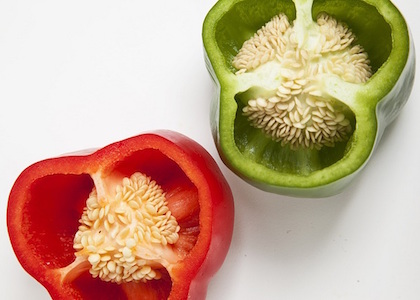
Why Red & Green Are So Good For You
By Stacy Kennedy, MPH, RD, CSO, LDN; Reboot Nutritionist
Beautiful, festive red and green fruits and veggies are loaded with health promoting nutrients. Here’s a closer look at why you should fill your plate and glass with some red and green goodness this holiday.
RED
Lycopene, a phytonutrient that lends a red hue to produce like pomegranate, tomato and watermelon is an important antioxidant and member of the carotene family, like its more well-known relative beta-carotene. Consuming lots of lycopene is linked to a reduced risk for prostate cancer.
Many red fruits like bell peppers, strawberries and raspberries are high in super immune booster, vitamin C, which also acts to promote healthy, strong skin as well as fight off those cold germs. Pomegranates are the third highest fruit source of antioxidants.
Ellagic acid found in strawberries may help reduce the risk of certain cancers like breast cancer. Raspberries also contain potassium, niacin, and some iron as well as vitamin C.
Cherries are champions of anti-inflammation helping to ease joint pain. Cranberries are high in antioxidants, particularly proanthocyanidins, which are known for supporting overall health.
Numerous studies have shown that beets can help oxygenate blood and enhance exercise performance. Beets are a good source of folic acid, and also contain vitamins A, C, choline, iodine, manganese, organic sodium, potassium, and fiber. Don’t forget to eat or juice those beet greens! The greens have even more iron than Popeye’s favorite veggie.
Watermelon contains vitamin A and C, as well as iron and potassium. Potassium rich fruits and vegetables are known for helping to keep blood pressure in check. Their high water content makes them ideal for juicing.
GREENS
Magnesium rich green leafy vegetables help with nerve conduction, ease muscle cramps, and support metabolism to name a few. Many are part of the cruciferous family of vegetables, best known for their potent liver detoxification promotion and cancer fighting phytonutrients.
Kale is a wonder vegetable! It has the highest vegetable source of vitamin K and may help the risk of developing certain cancers. It’s a fantastic source of calcium, chlorophyll, calcium, iron, and vitamins A and C. Kale is low calorie and yet incredibly dense with nutrients. It’s also a good source of minerals, copper, potassium, iron, manganese, and phosphorus, as well as compounds which promote eye and skin health.
Many green veggies are also a great source of vitamin C. There are more in kiwifruit than an orange! Vitamin C helps heal cuts and wounds and keep teeth and gums healthy.
Honeydew has potassium which can help to lower blood pressure and prevent muscle cramps from electrolyte imbalance.
Cucumbers contain potassium and phytosterols which can help lower cholesterol. They’re high in water, which make them great for juicing. Cucumbers are especially cooling, whether consumed in juice form or placed on the skin. Consume the dark green skin to get a boost of chlorophyll, but make sure the skin isn’t waxed.
Looking for more great green ideas for your next juice, smoothie, snack or meal? Check out some of these superstars! Broccoli, Swiss Chard, Collard Greens, Spinach, Zucchini, Green apple, Green cabbage or Celery.
Check out these delicious recipes for more ideas!
Butternut squash, Pomegranate & Pistachio Quinoa Salad
Fresh Veggie Enchilladas
Hail to Kale Salad
Holly Jolly Juice
Crazy for Cranberries Juice
Sweet and Sour Juice
A Green Vanilla Shake
Cold Busting Berry Smoothie